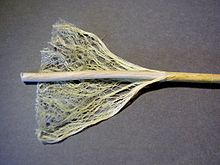Short fiber
When short fibers are natural fibers referred to the mm an average length of about 40 to 100, but always have more than one centimeter. During fiber digestion, they occur in addition to long and super short fibers . In contrast to traditional long fiber production, in which the natural fibers are separated into long fibers and tow , all fibers are used for short fiber digestion (entire line).
Fiber digestion of hemp and flax
Short-fiber digestion is less complex than long-fiber digestion , as production steps such as time-consuming water roasting (field roasting is sufficient) and swinging can be dispensed with. Since the fibers can also be used in a random position and accordingly do not have to be straightened, the handling of the fibers is also easier.
Short fibers are produced in modern digestion systems and optimized for technical use. To pre-treat the fiber breakdown of the short fiber and total fiber line, the hemp straw is shortened and roasted in the field (field roast) and then pressed into round or square bales; water roasting as with traditional long fiber processing is not required. The straw is fed in a random layer ( random fiber ) to a fiber pulping system and opened, then the material is broken in the crushing units consisting of differently sized toothed rollers to enable the fibers and the wood core to be separated. Over several steps, the wood components are as shives separated from the fibers, wherein the teilentholzte straw by preopener, cleaners, Vorauflöser and finally shaking and needle opening units out and becomes dissolved into smaller fiber bundles. The fiber bundles are further broken up and refined into individual fibers via further stage cleaning, rollers, carding devices and opening units.
use
Short fibers are mainly used for technical textiles such as felts and fleeces (non-wovens), for molded parts (especially for the automotive industry ), for natural insulation materials and for geo and agricultural textiles . They potentially play an important role as reinforcing fibers in plastics and composite materials ( natural fiber-reinforced plastics ), as they can be well distributed by trickling in and can also be used in the injection molding process .
literature
- Michael Carus et al .: Study on the market and competitive situation for natural fibers and natural fiber materials (Germany and EU). Gülzower Expert Discussions 26, ed. from the Agency for Renewable Raw Materials eV, Gülzow 2008 Download (PDF; 3.9 MB)
- nova-Institut (Ed.): Das kleine Hanf-Lexikon. Verlag Die Werkstatt, Göttingen, 2nd edition, 2003; Page 65. ISBN 3-89533-271-2
